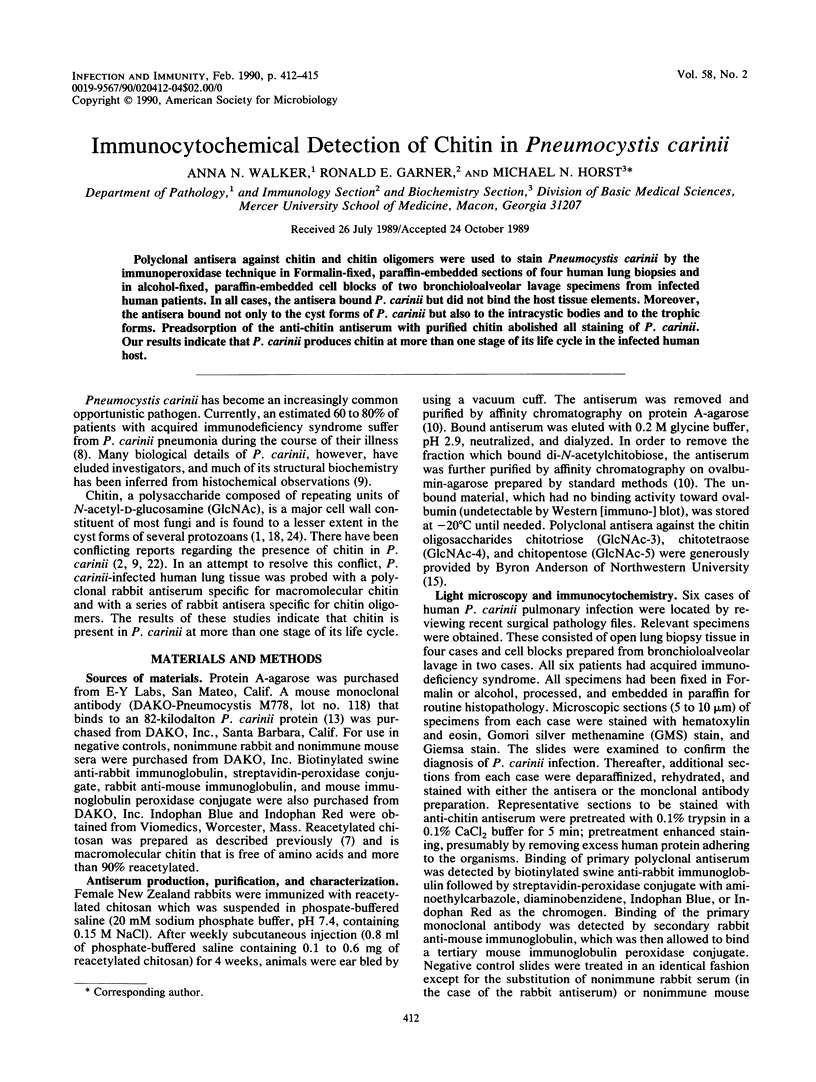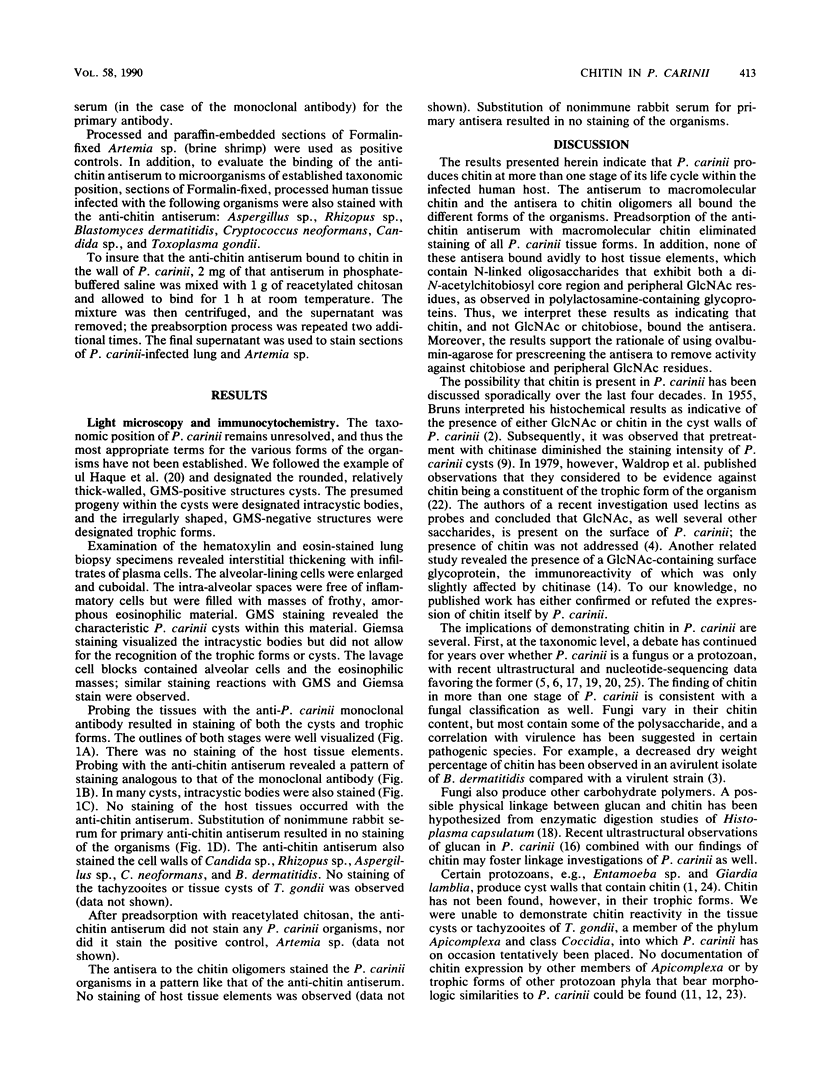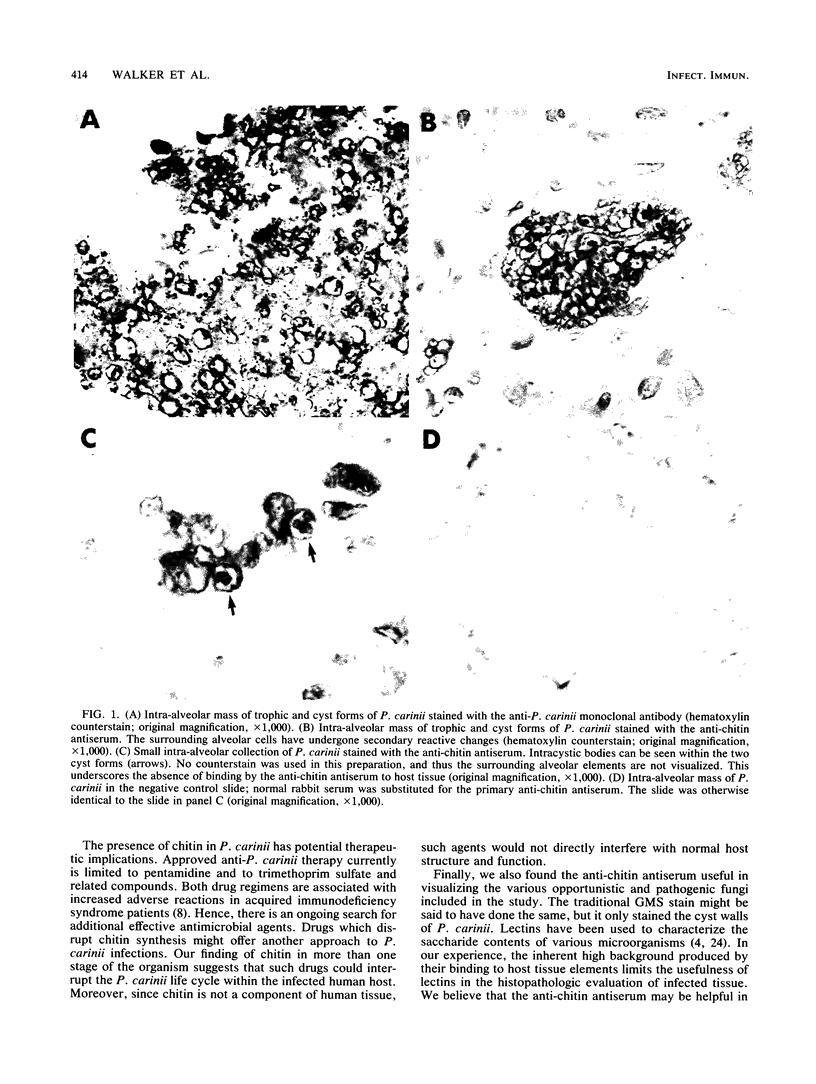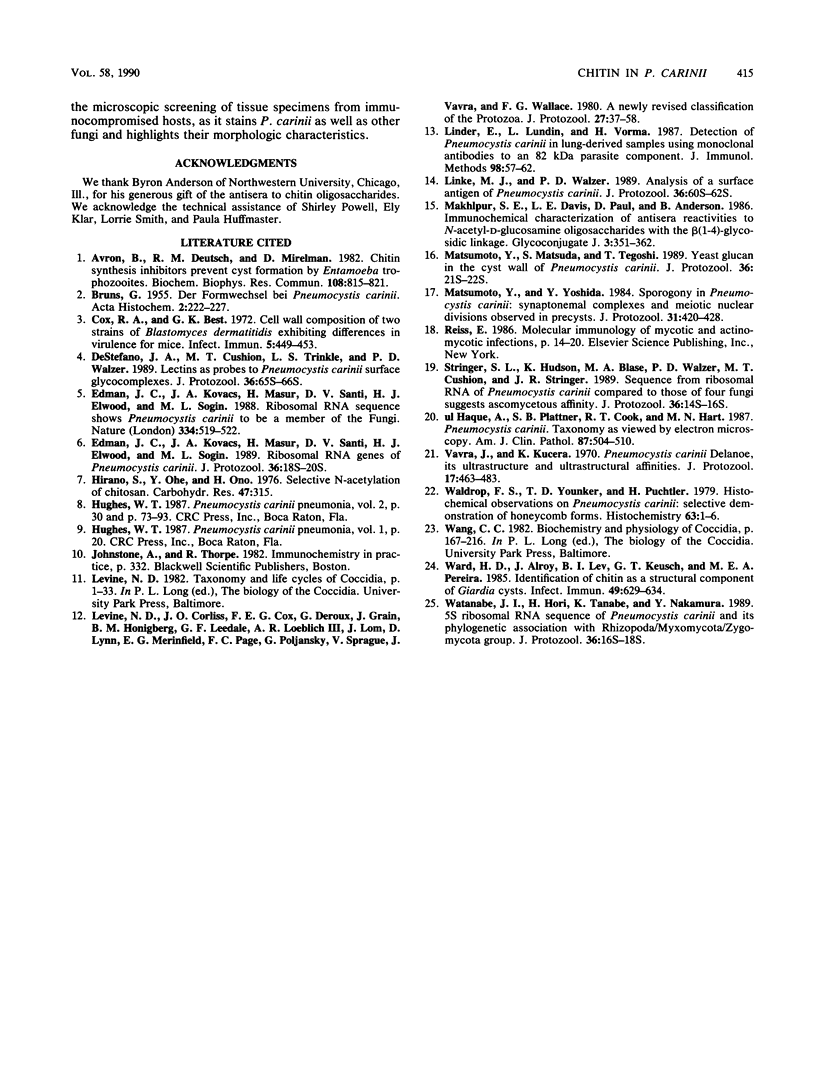Abstract
Polyclonal antisera against chitin and chitin oligomers were used to stain Pneumocystis carinii by the immunoperoxidase technique in Formalin-fixed, paraffin-embedded sections of four human lung biopsies and in alcohol-fixed, paraffin-embedded cell blocks of two bronchioloalveolar lavage specimens from infected human patients. In all cases, the antisera bound P. carinii but did not bind the host tissue elements. Moreover, the antisera bound not only to the cyst forms of P. carinii but also to the intracystic bodies and to the trophic forms. Preadsorption of the anti-chitin antiserum with purified chitin abolished all staining of P. carinii. Our results indicate that P. carinii produces chitin at more than one stage of its life cycle in the infected human host.
Full text
PDF



Images in this article
Selected References
These references are in PubMed. This may not be the complete list of references from this article.
- Avron B., Deutsch R. M., Mirelman D. Chitin synthesis inhibitors prevent cyst formation by Entamoeba trophozoites. Biochem Biophys Res Commun. 1982 Sep 30;108(2):815–821. doi: 10.1016/0006-291x(82)90902-0. [DOI] [PubMed] [Google Scholar]
- BRUNS G. Der Formwechsel bei Pneumocystis Carinii. Acta Histochem. 1956 Feb 29;2(5-6):222–227. [PubMed] [Google Scholar]
- Cox R. A., Best G. K. Cell wall composition of two strains of Blastomyces dermatitidis exhibiting differences in virulence for mice. Infect Immun. 1972 Apr;5(4):449–453. doi: 10.1128/iai.5.4.449-453.1972. [DOI] [PMC free article] [PubMed] [Google Scholar]
- De Stefano J. A., Cushion M. T., Trinkle L. S., Walzer P. D. Lectins as probes to Pneumocystis carinii surface glycocomplexes. J Protozool. 1989 Jan-Feb;36(1):65S–66S. doi: 10.1111/j.1550-7408.1989.tb02704.x. [DOI] [PubMed] [Google Scholar]
- Edman J. C., Kovacs J. A., Masur H., Santi D. V., Elwood H. J., Sogin M. L. Ribosomal RNA genes of Pneumocystis carinii. J Protozool. 1989 Jan-Feb;36(1):18S–20S. doi: 10.1111/j.1550-7408.1989.tb02672.x. [DOI] [PubMed] [Google Scholar]
- Edman J. C., Kovacs J. A., Masur H., Santi D. V., Elwood H. J., Sogin M. L. Ribosomal RNA sequence shows Pneumocystis carinii to be a member of the fungi. Nature. 1988 Aug 11;334(6182):519–522. doi: 10.1038/334519a0. [DOI] [PubMed] [Google Scholar]
- Hirano S., Ohe Y., Ono H. Selective N-acylation of chitosan. Carbohydr Res. 1976 Apr;47(2):315–320. doi: 10.1016/s0008-6215(00)84198-1. [DOI] [PubMed] [Google Scholar]
- Levine N. D., Corliss J. O., Cox F. E., Deroux G., Grain J., Honigberg B. M., Leedale G. F., Loeblich A. R., 3rd, Lom J., Lynn D. A newly revised classification of the protozoa. J Protozool. 1980 Feb;27(1):37–58. doi: 10.1111/j.1550-7408.1980.tb04228.x. [DOI] [PubMed] [Google Scholar]
- Linder E., Lundin L., Vorma H. Detection of Pneumocystis carinii in lung-derived samples using monoclonal antibodies to an 82 kDa parasite component. J Immunol Methods. 1987 Apr 2;98(1):57–62. doi: 10.1016/0022-1759(87)90435-2. [DOI] [PubMed] [Google Scholar]
- Linke M. J., Walzer P. D. Analysis of a surface antigen of Pneumocystis carinii. J Protozool. 1989 Jan-Feb;36(1):60S–61S. doi: 10.1111/j.1550-7408.1989.tb02701.x. [DOI] [PubMed] [Google Scholar]
- Matsumoto Y., Matsuda S., Tegoshi T. Yeast glucan in the cyst wall of Pneumocystis carinii. J Protozool. 1989 Jan-Feb;36(1):21S–22S. doi: 10.1111/j.1550-7408.1989.tb02674.x. [DOI] [PubMed] [Google Scholar]
- Matsumoto Y., Yoshida Y. Sporogony in Pneumocystis carinii: synaptonemal complexes and meiotic nuclear divisions observed in precysts. J Protozool. 1984 Aug;31(3):420–428. doi: 10.1111/j.1550-7408.1984.tb02989.x. [DOI] [PubMed] [Google Scholar]
- Stringer S. L., Hudson K., Blase M. A., Walzer P. D., Cushion M. T., Stringer J. R. Sequence from ribosomal RNA of Pneumocystis carinii compared to those of four fungi suggests an ascomycetous affinity. J Protozool. 1989 Jan-Feb;36(1):14S–16S. doi: 10.1111/j.1550-7408.1989.tb02670.x. [DOI] [PubMed] [Google Scholar]
- Vavra J., Kucera K. Pneumocystis carinii delanoë, its ultrastructure and ultrastructural affinities. J Protozool. 1970 Aug;17(3):463–483. doi: 10.1111/j.1550-7408.1970.tb04715.x. [DOI] [PubMed] [Google Scholar]
- Waldrop F. S., Younker T. D., Puchtler H. Histochemical observations on Pneumocystis carinii: selective demonstration of honeycomb forms. Histochemistry. 1979 Sep;63(1):1–6. doi: 10.1007/BF00508006. [DOI] [PubMed] [Google Scholar]
- Ward H. D., Alroy J., Lev B. I., Keusch G. T., Pereira M. E. Identification of chitin as a structural component of Giardia cysts. Infect Immun. 1985 Sep;49(3):629–634. doi: 10.1128/iai.49.3.629-634.1985. [DOI] [PMC free article] [PubMed] [Google Scholar]
- Watanabe J., Hori H., Tanabe K., Nakamura Y. 5S ribosomal RNA sequence of Pneumocystis carinii and its phylogenetic association with "Rhizopoda/Myxomycota/Zygomycota group". J Protozool. 1989 Jan-Feb;36(1):16S–18S. doi: 10.1111/j.1550-7408.1989.tb02671.x. [DOI] [PubMed] [Google Scholar]
- ul Haque A., Plattner S. B., Cook R. T., Hart M. N. Pneumocystis carinii. Taxonomy as viewed by electron microscopy. Am J Clin Pathol. 1987 Apr;87(4):504–510. doi: 10.1093/ajcp/87.4.504. [DOI] [PubMed] [Google Scholar]



